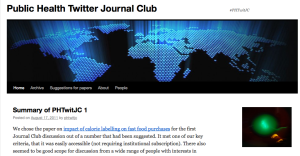The world is now a public health journal club richer! And this is a club not restricted to people in a specific university, from a particular workplace or with a special diploma. Everyone is free to actively join or follow it from the sidelines. Inspired by the first Twitter Journal Club, which focuses on research in clinical medicine, a Public Health Twitter Journal Club has now been set up.
T he concept is just as for a regular journal club. It is a group of individuals who meet regularly to critically evaluate recent articles in scientific literature. Journal clubs are usually organized around a defined subject, in this case Public Health. The clubs are commonly used by students. They can help students become more familiar with the advanced literature in their new field of study and improve the their skills of understanding and debating current topics of active interest in their field. But also for non-students is a good way to keep up with the literature and developments within one’s academic field.
he concept is just as for a regular journal club. It is a group of individuals who meet regularly to critically evaluate recent articles in scientific literature. Journal clubs are usually organized around a defined subject, in this case Public Health. The clubs are commonly used by students. They can help students become more familiar with the advanced literature in their new field of study and improve the their skills of understanding and debating current topics of active interest in their field. But also for non-students is a good way to keep up with the literature and developments within one’s academic field.
Discovering this new journal club made me wonder when the first journal clubs saw daylight. According to Wikipedia a British surgeon, Sir James Paget was the first to describe a group at St. Bartholomew’s Hospital in London in the mid-19th century as “a kind of club … a small room over a baker’s shop near the Hospital-gate where we could sit and read the journals.”
 Th
Th e first formalized journal club was supposedly established by a Sir William Osler at McGill University in Montreal i 1875, with the original purpose as follows “for the purchase and distribution of periodicals to which he could ill afford to subscribe.”
e first formalized journal club was supposedly established by a Sir William Osler at McGill University in Montreal i 1875, with the original purpose as follows “for the purchase and distribution of periodicals to which he could ill afford to subscribe.”
I wonder what Sir James and Sir William would say about this new journal club on Twitter. At least William Osler should be happy about the chance to discuss scientific article with colleagues around the world without having to use money for travel. And he would probably applaud that The Public Health Twitter Journal Club gives priority to articles published in open-access journals.
If you are not familiar with the concept of a Twitter journal club a “how it works” can be read at the original Twitter Journal Club. A quick recap is also given here. With a Twitter account everyone is free to follow the Twitter journal club chat. To follow and contribute to the discussion use the #PHTwitJC hashtag in your tweets. By searching for this in Twitter you can follow the discussion and contribute your self by adding the hashtag to you comments. The discussion takes place for about an hour at an agreed time. The people behind the journal club suggests discussions points to guide the talk. Soon after the discussion a transcript of the discussion and a summary can be found at the journal club website.
Launched 18 July 2011, so far only one article have been discussed. A BMJ article Impact of calorie labelling on fast food purchases. The article to be discussed next time is up for a vote. Everyone can make their voice heard and vote for one of the suggested articles or come up with other recommendations.
Having just gone on-air the Public Health Twitter Journal Club t is still new and knowledge of its existence limited (to date 132 are following it on Twitter). But as more and more public health people hopefully become acquainted with it and actively takes part in it, it can provide the basis for interesting public health discussions. A chance to conduct post-peer-review and perhaps expand ones network. And who knows perhaps the author will take part in the discussion or at least read it afterwards. The later being one of the added values of a Twitter journal club compared to the closed journal clubs that takes place inside buildings, classrooms or perhaps above a baker’s shop.
That the concept of a Twitter-based journal club seem to be catching on is seen from the succesful original Twitter Journal Club (focused on research in clinical medicine), but also by other journal clubs that a popping up. An Astronomy Journal Club on Twitter have for example so far attract lots of followers that are eager to discuss articles and academic papers on astronomy and astrophysics.
I myself have not yet participated in a Twitter Journal Club, but I look forward to expericing discussions where each comment, statement, view point is limited to 140 characters. It really forces the participant to be precis.
From a baker’s shop to Twitter: a new Public Health Journal Club emerges
The world is now a public health journal club richer! And this is a club not restricted to people in a specific university, from a particular workplace or with a special diploma. Everyone is free to actively join or follow it from the sidelines. Inspired by the first Twitter Journal Club, which focuses on research […]


